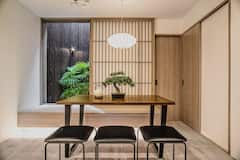Calming Kyoto has atmosphere. It’s located in a basin, so once you get out of the city center, Kyoto quickly becomes mountains. Alongside the mountains are places with quietly lingering temples, places like Oku Sagano. There are few people who come out this far, where sit profound, Kyoto-esque temples. In quiet, bamboo forest-surrounded Oku Sagano, there are two temples that I definitely want to visit. They’ll give you the wonderful Kyoto atmosphere. Let the serenity of the ancient capital heal you.
Adashino Nenbutsu-ji Temple: Enjoy a walk through a quiet bamboo forest

The famous Arashiyama near Togetsukyo Bridge. In spring there are cherry blossom trees, in autumn the changing leaves are gorgeous. It also has verdant green and snowy landscapes, all of which make it one of Kyoto’s best sightseeing spots. This area, where temples line the way from Arashiyama to Ogurayama, is called Sagano, a beautiful place immersed in a bamboo forest. It’s popular for its walking course that goes around the temples.
The area of Arashiyama has temples like Tenryuji, Nison-in, Gioji, Hokyo-in, Seiryoji, and although many tourists visiting the area stop at the northernmost Daikakuji Temple and head back to Arashiyama, the real gems of Sagano are in Oku Sagano!
Deep in Sagano are two small but richly atmospheric temples called Adashino Nenbutsu-ji and Otagi Nenbutsu-ji, where you can fully experience the serenity of the old capital.
First, I’ll introduce Adashino Nenbutsu-ji. It’s located in a back area 3km from Arashiyama and about 1km west from Daikakuji Temple. It’s a little far, and although you can take a bus there, renting a bicycle from the Togetsukyo Bridge area is recommended. The two temples I’m introducing have many hilly roads, so it’s more pleasant to rent an electric bicycle, although it’s a little more expensive. Ride a bike and tour Oku Sagano while enjoying the atmosphere of the old capital.
This picture is a bamboo forest in the grounds of Adashino Nenbutsu-ji.
Going from Saiin No Kawara, a place where approximately 8,000 stone Buddhist statues and monuments sit in rows, the forest is on the way as you head toward a small hill with 6 Jizo statues (protectors of small children and travelers). There is also the grave of an Edo-era industrialist deep within the bamboo. When the wind blows, you can hear the sound of rustling bamboo leaves, creating a serenity that seems to calm your heart. It’s a bamboo forest where you can feel the essence of Sagano.
Adashino Nenbutsu-ji: The vibrant fall colors that heal the sorrow of the deceased

This picture is of the Saiin No Kawara, a spot which I mentioned earlier. Saiin is the name of a place in Kyoto which was called ‘Sai’ in the Middle Ages. Kawara refers to the Sanzu River, which in Buddhism is said to run along the western edge of Hell, and is said to be where children who die before their parents must pile up stones on the riverbed as punishment. Unfortunately, in this sad legend, a demon comes and destroys their stone piles, meaning that the children must be forever piling them up. However, Jizo Bosatsu (represented in the above Jizo statues) is said to rescue these children.
By the way, the name Adashino is uncommon in Japanese, with Adashi being an old word meaning ‘futile’ or ‘void’. In Japanese, Adashi is written with a character that represents change, in this case life changing to death, and it incorporates the meaning of a wish for rebirth in this life and for passing on to the Buddhist paradise.
Since ancient times, this area was actually where bodies of the deceased were discarded, a sorrowful place where the dead where left exposed to the elements, without a proper burial. In the Heian Period (794 to 1185), a monk constructed Gochiyama Nyoraji Temple here to mourn for the exposed dead, which was the beginning of Adashino Nenbutsu-ji Temple.
Hundreds of years passed from the Heian Period, and then in the Meiji Period (1868-1912), the scattered bodies of the dead were gathered up by locals and enshrined in Adashino Nenbutsu-ji Temple. These grounds are indeed rich with sorrow. However, Adashino Nenbutsu-ji is peaceful place with beautiful fall colors, as you can see in the photo. You can feel the beauty of the area changing the sorrow to a sense of peace.
In August, candles are placed on the statues and lit in a ceremony known as Sento-Kuyo, a summer tradition which attracts many people (reservation required). The sight of thousands of Buddhist statues illuminated under the soft orange glow of innumerable candles is a moving and almost mystical scene. You’ll sense of the serenity of the old capital.
Adashino Nenbutsu-ji Temple Telephone: 075-861-2221 Bus Stop: Kyoto Bus - Torimoto Bus Stop Holidays: None (expect during some religious ceremonies) Visiting Hours: 9:00am - 4:30pm (varies by season) Entrance Fee: 500 JPY for adults, 400 JPY for junior and senior high school students, free for children Restroom Equipped (wheelchair accessible)
The well-kept secret within a well-kept secret! The tightly arranged unique Buddhist statues of Otagi Nenbutsu-ji

Next, I’d like to introduce one more temple. From Adashino Nenbutsu-ji, it’s located about 600 meters west up a hill road. On the way, you’ll come upon a three-forked road where Hiranoya tea house sits. Take the road on the right, and in front of Otagi Nenji Mae Bus Stop are the red gates of Otagi Nenbutsu-ji.
Otagi Nenbutsu-ji Temple, written with characters that are normally read as Atagi in Japanese but here are read as Otagi, is located in the deepest part of Oku Sagano. With few people coming this far, it’s a well-kept secret within a well-kept secret. What I recommend at this temple is the rows of stone Buddhist statues with unique faces, as you can see below, because they’ll put you in a pleasant, light-hearted mood.
You might be interested in these Airbnbs!
Otagi Nenbutsu-ji: The charming Buddhist saints that will give you the strength to persevere

Otagi Nenbutsu-ji was built in the 8th century. Over a long period of time, flooding and disasters left the temple in ruins. Later on, it was decided in the Showa era (1926-1989) to restore the temple. After asking the general public for carved stone Buddhist statues known as rakan, a surprising 1200 people submitted rakan that they had carved themselves.
Adashino Nenbutsu-ji’s statues are very old, but those at Otagi Nenbutsu-ji are new, and have more of a modern art aesthetic. Carved over the course of 10 years, each stone statue is quite unique. Some hold cats or straw bags, some laugh heartily, all seem to be doing as they like and carved with a freewheeling spirit, no two being the same. In any case, they all seem to be happy, having cheerfully content faces, and a visit here will immerse you in their warm, happy mood. “For now, I’ll just keep on going.” Otagi is a temple that will give you the courage to feel this way.
Otagi Nenbutsu-ji Phone: 075-865-1231 Bus Stop: Kyoto Bus - Otagi Nenji Mae Bus Stop Holidays: None Visiting Hours: 8:00am - 5:00pm Entrance Fee: 300 JPY general admission, free for junior high students and younger Restroom Equipped (not wheelchair accessible)
Adashino Mayu Mura: A shop with unique cocoon dolls that you can also make yourself

Lastly, an Oku Sagano souvenir. It’s the above horse, but doesn’t it look incredibly soft to you? This doll is made of the cocoons that insects are wrapped in as larva. The place making these cocoon items is Adashino Mayu Mura. This is indeed a unique place, and as a staff member there told me, “Perhaps this is the only Cocoon doll specialty shop in the world”. Not only horses, they also sell figures in the shape of humans, dragon flies, hanging room decorations, and other souvenirs rich with Kyoto’s sentimentality. Just looking at them will make you feel better. There is a shop located on the road leading to Adashino, with another in front of Arashiyama’s Tenryuji Temple. They also hold workshops where you can make your own items.
Wrapping it up
So, what do you think? Oku Sagano is very calming, a place where you can experience the tranquility of the old capital. Look up, find yourself surrounded by a bamboo forest, and hear the faint rustling of bamboo in the wind. A trip to Kyoto and Oku Sagano. Enjoy the refreshing serenity in paths through tranquil bamboo forests and temples.
History
Get Trip101 in your inbox
Unsubscribe in one click. See our Privacy Policy for more information on how we use your data




















Create an account to